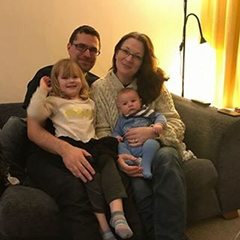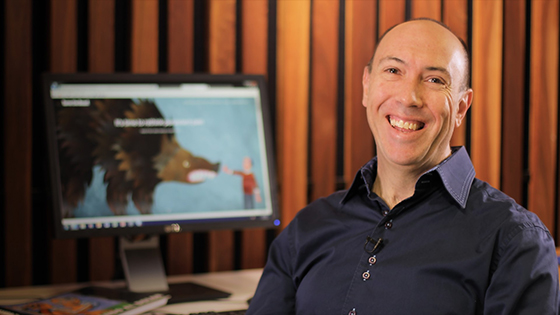
Rhea on her last day of therapy.
When Rhea Crighton was told she was in remission seven months after a cervical cancer diagnosis, she thought that a sense of normalcy would return. She didn’t expect to learn that she would need to adjust to persistent pain.
Rhea came across the work of Professor Lorimer Moseley, a leading expert in modern pain science, which inspired her and she discovered a way to overcome and manage her pain and add new tools to her work as a pain nurse.
“Critically for me as a cancer survivor, I have learnt that hurt doesn’t always equal harm,” says Rhea when asked about her experience of living with pain.
She is sharing her story to help raise awareness of the need for a new project Professor Moseley and his team are undertaking to create a targeted self-management program for cancer survivors living with chronic pain.
Rhea’s story:
My name is Rhea. I am a 36 year old wife, mother of two (and one fur baby), pain management clinical nurse specialist and cancer survivor.
My son was just 12 weeks old when I was diagnosed with stage 2b node positive cervical cancer. I had complications throughout my pregnancy, but my son was healthy and the placenta normal so the symptoms were put down to pregnancy. After giving birth my symptoms worsened and the cancer was found.

My hubby James, daughter Amelia and son Dylan just after I was diagnosed.
Treatment included five weeks of chemotherapy (I only managed three due to severe illness and dehydration), alongside external radiotherapy and followed by internal brachytherapy. When I was given the all clear I realised I had to learn to adjust to a range of side-effects including chemo-induced peripheral neuropathy (nerve damage) and pain from radiation damage.
I’m not alone in this. The number of individuals living with and beyond cancer is growing. Many survivors like myself live with a range of social, psychological and practical issues as well as pain. Tools that give survivors the skills and knowledge they need to manage effects like pain and improve their wellbeing are vital.
Pain is a daily occurrence in my life, but I’ve learnt how to manage it. Educating myself about my pain using a number of tools, including Professor Moseley’s work, has meant that I can continue to do and enjoy the same things I always have in life, albeit with a bit of thought and planning.
This didn’t happen immediately. When I first developed nerve pain in my feet I thought I would never be able to walk again. The pain was so debilitating. But the skills I learnt have allowed me to return to work full time, study, raise a family, and I even completed my first walking marathon in aid of a local charity.
I have daily musculoskeletal pain in my right hip that physiotherapy, stretching and strengthening exercises help somewhat. I also have hypersensitivity across my pubis, as well as burning, tingling and numbness in my feet and up my legs. I also experience a sandpaper sensation in my fingertips and carpal tunnel.
Lorimer Moseley’s and David Butler’s Protectometer discusses the DIMs and SIMs of understanding pain. DIMs (Danger in Me) and SIMs (Safety in Me) are the ‘neurotags’ that can identify triggers or relievers of pain.
So to manage my pain I increase my SIMs – such as massage, heat, puzzles, reading, my work and time with my family; and I work to manage my DIMs – things like stress, my feet getting too hot, prolonged repetitive actions, my family and scans (the latter two are definitely both a SIM and a DIM). When I need more help I stick with adverse effect free pain management to keep the pain volume on a gentle hum. On the odd occasion the volume increases I turn to TENS or acupressure/acupuncture and focus on my SIMs.

Having a well-earned SIM towards the end of my marathon walk.
What is most important is that my pains do not stop me from engaging in activities, and I am confident that I can manage the pain and that it doesn’t always equal harm.
Understanding this last point is critical for many cancer survivors with pain.
I experience a lot of anxiety when it is time for a follow up with the oncology team, or when I’m waiting for scan results (scanxiety!). There are brief moments where every cough, headache, back ache, feels like a possible recurrence. To cope I turn to the skills I have developed to manage pain, as well as Cognitive Behavioural Training to try to rationalise these experiences. Nine out of 10 times the symptoms settle along with the fear. If they don’t I call my nurse specialist for advice as talking helps me find perspective.
I often see my pain system as a smoke alarm. Something triggers the sensor (DIM) to warn me that there is a potential fire (hip pain), however, it is up to me to decipher whether there really is a fire (cancer recurrence) or whether it is just a piece of burnt toast (musculoskeletal pain), and whether I need to call emergency (my oncology team) or ignore the toast (apply heat, stretch and keep active).
But I have to admit, it is a difficult and fine line to walk between complacency and paranoia.
Education is empowering, especially when combined with validation, which is often neglected in pain conditions. I have often felt that I should just be grateful that the cancer is treated and the pain is just an unfortunate side-effect that I need to put up with.
There is a gap in the follow up care of cancer survivors regarding bringing together knowledge in pain and cancer. Cancer survivors need better access to psychosocial (psychological and social behaviours) education and support. It is imperative that people living with and beyond cancer have strategies and tools to manage their anxieties, fears, and their pain so they can return to as normal a life as possible.
I am excited to see the outcome of Professor Moseley’s project and I urge you all to visit his crowdfunding page and help however you can.

With your support, we are taking what we know about pain, the body and mind and developing a new intervention aimed at reducing pain for cancer survivors and increasing their quality of life.